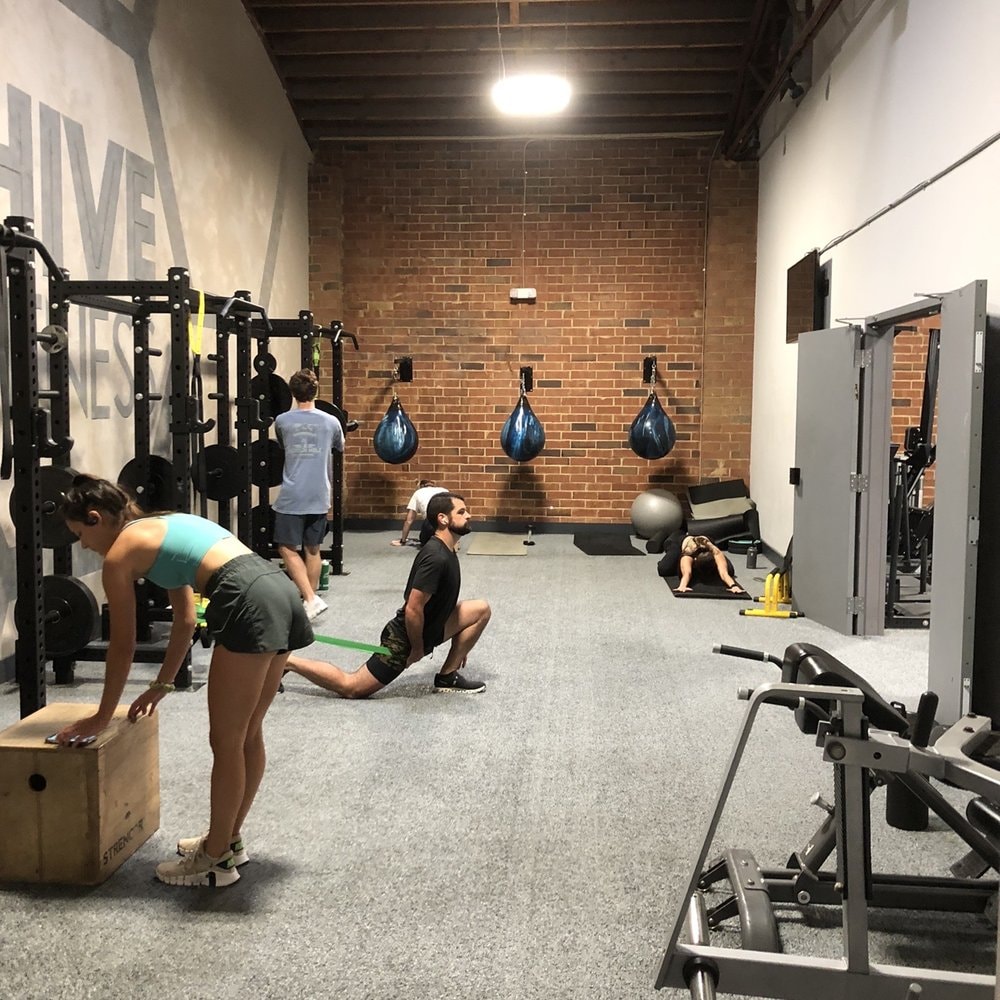Want to open your own gym in Australia, and need a gym business plan?
Whether you’re a seasoned fitness professional or an entrepreneur with a passion for health and wellness, starting a gym business can be a fun and rewarding experience. But like any business, it requires planning and strategy to succeed in the fitness industry. Effective business planning is crucial for securing funding, determining equipment budgets, and making informed decisions about location and services offered.
That’s where a gym business plan comes in. You can choose to have our expert team write your gym business plan for you (while leveraging our experience in this industry), or you can give it a go yourself, which is what I’ll cover in this article. From market research and financials to marketing and operations, by the end of this article you’ll have a step-by-step understanding of how to turn your fitness business dream into a reality.

Australian Fitness Industry
Before we get into the nitty gritty of your gym business plan, it’s important to understand the Australian fitness industry. According to Fitness Australia, the industry body, the fitness industry in Australia is worth over $3 billion per annum and has over 35,000 employees.
The industry has shown growth and resilience to changes in the market over time. A 2022 report by IBISWorld shows the gym and fitness centres industry in Australia will grow at an annualised 2.5% over the five years to 2026-27 to reach $2.7 billion.
This is due to:
-
Growing health awareness in Australians
-
Rising obesity and the need for preventative health measures
-
Government backing for physical activity
-
Fitness equipment and tracking technology
-
Boutique and specialisation
Knowing this will help you position your gym business in the market and tailor your services to the changing needs of Australian fitness enthusiasts.
Why do you need a Gym Business Plan?
A solid business plan is more than a document; it’s a roadmap for your business. It does several things for you:
Item |
Outcome |
|---|---|
Clarity of vision |
Writing a business plan makes you articulate your goals, target market and unique selling proposition. |
Strategic direction |
It helps you think through every aspect of your business, from operations to marketing, so you have a plan. |
Financial planning |
A business plan has financial projections so you can see your startup costs, ongoing expenses and revenue streams. |
Attract funding |
If you’re looking for external funding, a business plan is crucial for attracting investors or getting a bank loan. |
Risk management |
By researching the market and your business model you can identify the risks and develop strategies to mitigate them. |
Performance management |
Once your gym is open, your business plan will be a benchmark to measure your actual performance. |
Now we know why a gym business plan is important, let’s get into the components.

Executive Summary (Business at a Glance)
The executive summary is the first section of your business plan but it’s often best to write it last. This section is a summary of your entire business plan, highlighting the key points from each section. It should be short and sweet and give the reader a clear picture of your gym business in a few paragraphs.
Key points to include in your executive summary:
-
Business Concept: Briefly describe your gym, location and target market.
-
Company Overview: Provide a detailed section that includes your vision and mission statements.
-
Mission Statement: Define your gym’s purpose and values.
-
Unique Selling Proposition: What makes your gym different?
-
Financials: Summarise your financial projections, startup costs, expected revenue and profitability timeline.
-
Funding: If you’re looking for investment, state how much you need and what it will be used for.
Remember your executive summary should be good enough to make the reader want to read more of your full business plan.
Company (What is your gym?)
The company section provides more detail about your gym business. This is where you describe what your gym is, what it stands for and how it will operate.
Include:
Section |
Description |
|---|---|
Business structure |
What is your legal structure (e.g. sole trader, partnership, company). In Australia, common business structures for gyms are sole trader, partnership, company or trust. |
Location |
How big will your gym be and what type of equipment will you have? Will you focus on strength training equipment, cardio machines or a mix of both? |
Facilities |
How big will your gym be and what type of equipment will you have? Will you focus on strength training equipment, cardio machines or a mix of both? |
Services |
What services will your gym offer? Personal training sessions, group fitness classes, nutritional counselling, specialised programs? |
Hours of operation |
When will your gym be open. Many Australian gyms are 24/7 to cater for different schedules. |
Staffing |
How many staff and what roles (e.g. personal trainers, front desk, maintenance). |
Mission and values |
Define your gym’s mission (what you want to achieve) and vision (where you see your gym in the future). |
By the end of this section the reader should have a good understanding of what your gym business is and how it will operate.

Market Analysis (Your Competitive Landscape)
A market analysis is critical to position your gym in the Australian fitness industry. This section should show your understanding of the local fitness market, your target audience, your target market and your competition.
Elements of your market analysis include:
Industry Overview
- Current data on the Australian fitness industry, market size, growth trends and key players. Use reputable sources like Fitness Australia or IBISWorld for the latest statistics.
Target Market
- Who is your primary target market? Age, income level, fitness goals, lifestyle. Are you targeting young professionals, families or seniors?
Market Segmentation
- Break down your target market into segments. Casual gym goers, serious athletes, weight loss seekers, rehabilitation patients.
Market Size and Growth
- Estimate the size of your target market in your local area and its growth potential. Use demographic data from the Australian Bureau of Statistics to support your numbers.
Competitor Analysis
- Who are your direct competitors? Other gyms in your area, indirect competitors like home fitness equipment providers or outdoor boot camps. What are their strengths, weaknesses and market position.
SWOT
- Do a SWOT (Strengths, Weaknesses, Opportunities, Threats) analysis for your gym business. This will help you identify your competitive advantages and challenges.
Trends and Opportunities
- What are the current trends in the Australian fitness industry and how will your gym play into them. Functional fitness, technology integration, growing demand for holistic wellness services.
By doing your market analysis you’ll be able to tailor your gym’s offerings to your target market and stand out in the fitness landscape.
Services and Products (What your gym will offer)
In this section you’ll list the services and products your gym will offer. Your offerings should match your target market’s needs and wants and differentiate you from the competition.
Include:
Services |
Description |
|---|---|
Gym memberships |
Outline your membership structure. Tiers (basic, premium, VIP)? Contract lengths and pricing? |
Personal training |
Describe your personal training services. How will you recruit and train your personal trainers? Specialisations? |
Group fitness classes |
List the classes you’ll offer. HIIT, yoga, spin, Pilates etc. And unique offerings that will set you apart. |
Specialised programs |
Will you offer programs for specific goals or demographics, weight loss challenges, senior fitness, pre/post-natal classes. |
Nutritional services |
Will you offer nutritional counselling or meal planning to complement your fitness services? |
Equipment |
What types and brands of equipment will you have. Strength training equipment, cardio machines or a balanced mix? |
Retail products |
If you’ll sell products list what you’ll offer. Supplements, workout gear, branded merchandise. |
Technology integration |
Fitness apps, wearable tech integration, virtual training. |
Additional amenities |
Sauna, recovery zone, smoothie bar? |
Remember to explain how each of these adds value for your members and contributes to your unique selling proposition.

Marketing Strategy (Getting and Keeping Members)
A good marketing strategy is key to getting new members and keeping existing ones. In this section outline how you’ll market your gym and build your brand in the Australian market.
Components of your marketing strategy include –
Brand Positioning
- What is your gym’s brand? What values do you represent? How do you want to be seen in the market?
Digital Marketing
-
Website: What will your website look like?
-
Social Media: What will your social media strategy be across Instagram, Facebook and YouTube?
-
Content Marketing: What will your blogs, videos or podcasts be?
-
Email Marketing: How will you use email to nurture leads and members?
Traditional Marketing
-
Local Advertising: Radio, print, outdoor advertising in your area.
-
Community Engagement: What events will you participate in or sponsor sports teams.
Promotions and Offers
-
New Member Specials: What will your introductory offer or free trial be?
-
Referral Programs: How will you incentivise member referrals?
-
Seasonal Promotions: What marketing campaigns will you run around New Year or before summer.
Partnerships
-
Local Businesses: What corporate memberships will you offer to local companies?
-
Health Professionals: Will you partner with physiotherapists or nutritionists?
Customer Retention
-
Member Engagement Programs: How will you keep members engaged and connected?
-
Loyalty Rewards: Will you have a points system or special perks for long term members.
Public Relations
-
Media Relations: Who will you reach out to in the media?
-
Community Involvement: How will you give back to the community.
Metrics and Evaluation
-
KPIs: What are your key performance indicators for your marketing?
-
Analytics: How will you track and measure your marketing?
Remember to tie your marketing strategy to your target market and budget. A good marketing plan will be key to getting your gym established in the Australian fitness market.
Gym Membership Types Comparison
Membership Type |
Access Hours |
Classes Included |
Personal Training Sessions |
Price (AUD/month) |
Contract Length |
|---|---|---|---|---|---|
Basic |
6am - 10pm |
None |
None |
$49.99 |
Month-to-month |
Standard |
24/7 |
2 per week |
1 per month |
$79.99 |
3 months |
Premium |
24/7 |
Unlimited |
2 per month |
$119.99 |
6 months |
VIP |
24/7 |
Unlimited |
4 per month + priority booking |
$159.99 |
12 months |
Student |
24/7 |
2 per week |
None |
$39.99 |
3 months |
Senior |
8am - 8pm |
3 per week |
1 per month |
$59.99 |
3 months |
This table provides a clear overview of the different membership options you could offer, catering to various customer needs and preferences. You can adjust the specific details to align with your gym's unique offerings and target market.
Operational Plan (How You’ll Run Your Gym)
Your operational plan is the day to day running of your gym. This section should give a clear picture of how your gym will be efficient and deliver a great experience to members.
Components to include:
Facility Management
-
Maintenance Schedule. What’s your maintenance schedule for equipment and the facility?
-
Cleaning Protocols. What are your cleaning and hygiene standards?
Staffing
-
Organisational Structure. What’s your management hierarchy?
-
Hiring Process. How will you recruit and select staff? What qualifications will you require?
-
Training Programs. What ongoing training and development will you offer your team?
-
Scheduling. How will you manage staff rosters to ensure adequate coverage.
Member Management
-
Registration Process. How will new members sign up and onboard?
-
Check-in System. What will your check-in system be?
-
Member Communication. How will you communicate to members about classes, changes or promotions?
Class and Training
-
Class Schedule. What’s your group fitness timetable?
-
Booking System. How will members book classes or personal training?
-
Instructor Management. How will you schedule and manage fitness instructors.
Equipment and Inventory
-
Equipment Procurement. What’s your plan for buying and replacing equipment?
-
Inventory Management. How will you track and reorder supplies and retail items.
Technology
-
Management Software. What gym management software will you use for operations?
-
Payment Processing. How will you process membership fees and other payments?
-
Member App. If you have one, what features will your app have?
Risk and Safety
-
Emergency Procedures. What are your procedures for medical emergencies or accidents?
-
Insurance. What types of insurance will your gym have?
-
Compliance. How will you comply with Australian health and safety regulations.
Sustainability
-
Energy Efficiency. Will you use energy efficient equipment or practices?
-
Waste Management. How will you recycle and reduce waste.
By having an operational plan in place you’ll show potential investors or business lenders you have a clear understanding of what it takes to run a gym business in Australia.

Management Team (Your Leadership Structure)
A strong management team is key to your gym business. This section should showcase the expertise and experience of your key team members and how their skills work together to make your gym successful.
Be sure to include –
Management team |
Description |
|---|---|
Leadership team |
|
Organisational structure |
|
Advisory board or mentors |
|
Recruitment |
|
Training and development |
|
Succession planning |
|
Remember investors put a lot of weight on the management team when evaluating a business plan. Showcasing a strong team will increase confidence in your gym business plan.
Financial Projections
The financial projections section is where you’ll demonstrate the viability and profitability of your gym business. This section should provide a detailed forecast of your gym’s financial performance over the next 3-5 years.
Components to include:
Startup Costs
-
All initial expenses, equipment, facility renovations, legal fees, marketing costs.
-
How will you allocate your startup capital.
Revenue Projections
-
Monthly and annual revenue for the first 3-5 years.
-
Breakdown of revenue streams (e.g. membership fees, personal training, class fees, retail sales).
-
What are your assumptions behind the projections (e.g. membership growth rates, average revenue per member).
Ongoing Expenses
-
All ongoing expenses, rent, utilities, staff salaries, equipment maintenance, marketing costs.
-
How will these expenses change as your gym grows.
Cash Flow
-
Month by month cash flow for the first year, then annually for the following years.
-
So you’ll have enough cash to cover expenses as your business grows.
Break-Even
-
Calculate and explain your break even point – when your revenue covers all your costs.
-
When will your gym be profitable.
Profit and Loss
-
Project your gym’s profitability over the next 3-5 years.
-
How will revenue and expenses change as your business matures.
Balance Sheet
-
Projected balance sheet showing assets, liabilities and equity.
Key Financial Metrics
-
Gross margin, net margin, return on investment.
-
Compare to industry benchmarks where possible.
Be realistic with your projections. Overly optimistic forecasts will undermine your entire business plan. It’s often helpful to provide both conservative and optimistic scenarios so you’ve considered different outcomes.
Funding (How to Get the Capital for Your Gym)
If you’re looking for external funding for your gym this section is important. Here you’ll outline how much capital you need, what it will be used for and how you will get it.
Item |
Description |
|---|---|
Total funding required |
|
Sourced of funding |
|
Type of funding |
|
Use of funds |
|
Return on investment |
|
Exit |
|
Collateral |
|
Gym Startup Cost Calculator Australia
Note: This is a rough estimate. Actual costs may vary. Consult with local experts for more accurate figures.
Remember to tailor this to your audience. A bank will have different concerns than a venture capitalist or angel investor.

Legal (Australian Regulations)
Running a gym in Australia means compliance with many legal and regulatory requirements. This section should show you understand these obligations and how you will meet them.
Include:
Business Registration
-
How to register your business in Australia.
-
What business structure have you chosen (e.g. sole trader, partnership, company) and why.
Licenses and Permits
-
What licenses and permits are required to run a gym in your area.
-
This may include local council permits, music licensing and food handling permits if you’re offering food or supplements.
Insurance
-
What types of insurance do you need (public liability, professional indemnity, property insurance).
-
What are the coverage amounts and costs.
Health and Safety
-
How will you comply with Work Health and Safety (WHS) regulations.
-
What are your emergency procedures and first aid provisions.
-
Employee Laws:
-
How do you understand Fair Work Australia regulations around employment contracts, wages and working conditions.
Privacy
-
How will you comply with the Australian Privacy Principles with member data.
Contracts
-
What are the key components of your membership contracts and how do they comply with Australian Consumer Law.
Intellectual Property
-
If applicable, what trademarks or patents will you register.
Tax
-
How do you understand tax requirements, including GST, payroll tax and company tax.
By covering these legal considerations you’re showing potential investors or lenders you’re ready to run your gym business in compliance with Australian laws and regulations.
Risk (What Could Go Wrong)
Every business has risks and a gym is no exception. This section should list the risks to your business and how you’ll mitigate them.
Think of these risks –
Market Risks
- Competition: What if new gyms enter the market or existing ones improve their offerings?
- Market change: What if the fitness trend shifts away from traditional gyms?
Operational Risks
- Equipment failure: What if major equipment breaks down?
- Staff turnover: How will you retain key staff and replace those who leave quickly?
Financial Risks
- Cash flow: What if membership growth is slower than expected?
- Increase in costs: What if rent or equipment costs go up?
Legal and Regulatory Risks
- Changes in health and safety regulations: How will you keep up with changing rules?
- Liability claims: How will you prevent and manage injury claims?
Reputational Risks
- Bad reviews or publicity: How will you manage your gym’s online reputation?
- Health scares: What if there’s a COVID-19 outbreak linked to your gym?
Economic Risks
- Economic downturn: How would you adjust if disposable income decreases and people cut back on gym memberships?
Technology Risks
- Cybersecurity: How will you protect member data from being hacked?
- Obsolescence: How will you keep up with the fast pace of fitness technology?
For each risk:
- What is the risk?
- How will it impact your business?
- How will you mitigate/manage the risk?
Remember you don’t have to eliminate all risks (which is impossible) but show you’ve thought through the potential issues and have a plan for them.

Summary (be sure to nail the landing!)
In this final section summarise the main points of your gym business plan and why your gym will succeed in the Australian fitness market.
Include:
-
Key Strengths: What are the main differences between your gym and the competition.
-
Market Opportunity: What gap in the market will your gym fill and why now.
-
Team: Who’s in charge and can deliver the plan.
-
Financials: Summarise your financials, show profitability and growth.
-
Ask: If seeking investment, what are you looking for and what’s next.
-
Future: End with a big vision for your gym in 5-10 years, so they believe in your long term success.
Remember leave the reader excited about your gym and confident you can make this business plan happen.
What now?
By following this guide you’ll have a gym business plan that’s specific to the Australian market. This plan will help you get funding and run your business but also be a roadmap for your gym’s success in the fitness industry.
Remember a business plan is a living document. As your gym grows and the market changes be prepared to review and update your plan regularly. With planning, hard work and a commitment to delivering great fitness experiences your gym will succeed in the Australian fitness landscape.
Good luck with your gym business venture!

